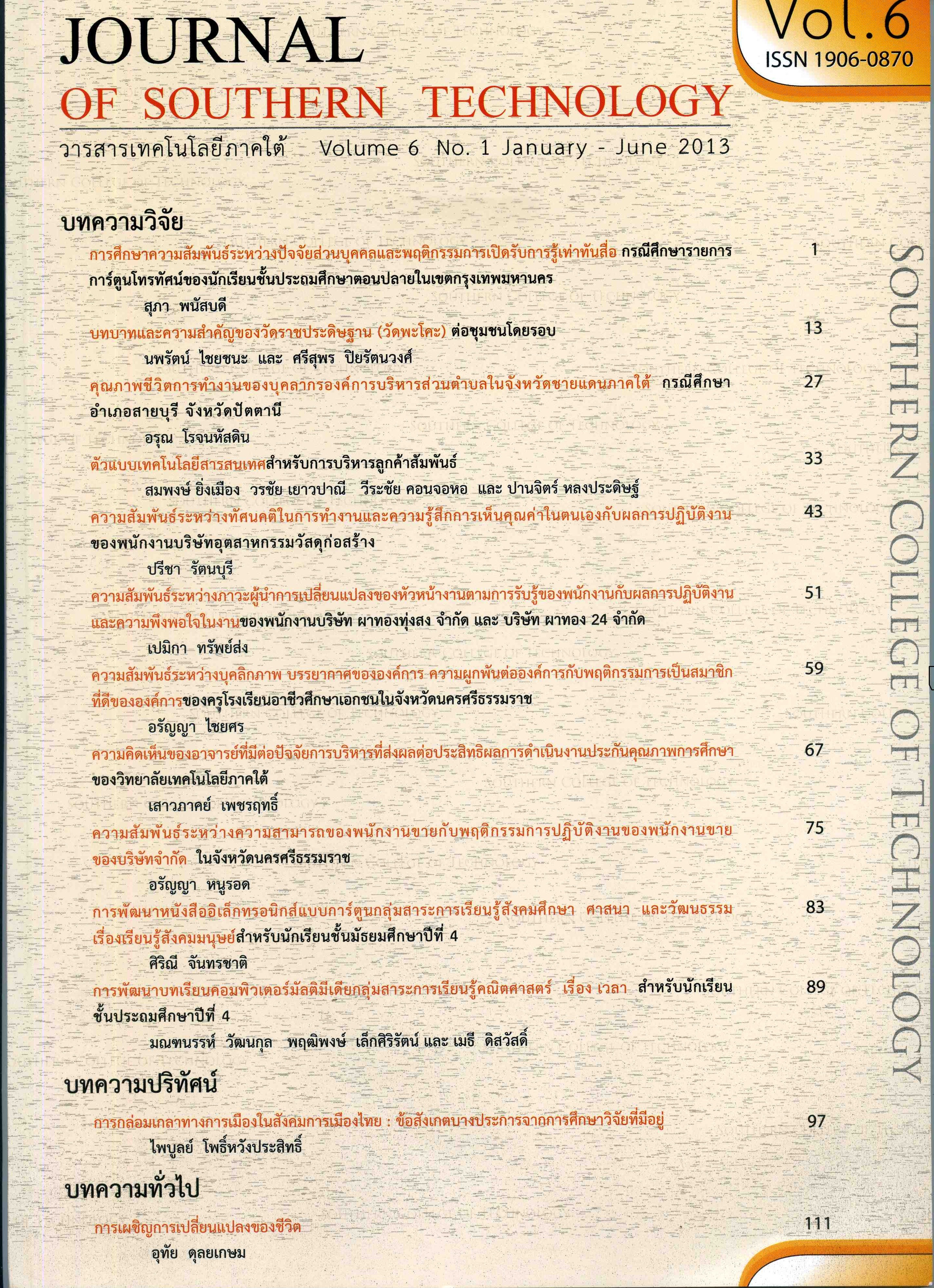The Information Technology Model for Customer Relationship Management
Main Article Content
Abstract
The purpose of this research was to develop an information technology model for customer relationship management (ITCRM). The sample was a resort located in Hua Hin, Prachuap Khiri Khan Province. The tool was a set of questionnaires. The data were analyzed employing percentage, mean, and Chi-square.
The results were obtained. 1) The efficiency of information technology model for customer relationship management applying the Kendall Coefficient of Concordance was approved and accepted as an efficient model by experts. The consistent acceptance was made from the statistical significance of 0.01. 2) The test of satisfaction for customer relationship management model was made by the resort personnel and more than 90% of them revealed to be satisfied with the model at a high and highest level with statistical significance of 0.01. 3) More than 90% of the clients felt very satisfactory, or at a high and highest level with statistical significance of 0.01.
The contribution in this research is ITCRM model and the development process quality for thoroughly checking in all steps. The model was developed and integrated into a new innovation and could be applied with information technology model for customer relationship management.
Article Details
-
Authors must agree to the journal publication rules and allow the editors to edit the manuscripts for publication.
-
Author’s right belongs to the author but Journal of Southern Technology holds the right of first publication and thus allow readers to use the article for the purpose of education but not commercial.
References
กิติศักดิ์ พลอยพานิชเจริญ. (2551). หลักการการควบคุมคุณภาพ. กรุงเทพฯ : สมาคมส่งเสริมเทคโนโลยี (ไทย-ญี่ปุ่น).
เชฐธิดา กุศลาไสยานนท์. (2550). ผลกระทบของศักยภาพด้านเทคโนโลยีสารสนเทศและประสิทธิผลการบริหารลูกค้าสัมพันธ์ที่มีต่อผลการดำเนินงานของบริษัทจดทะเบียนใน ตลาดหลักทรัพย์แห่งประเทศไทย. วิทยานิพนธ์ บริหารธุรกิจมหาบัณฑิต สาขาวิชาการจัดการเทคโนโลยีและพาณิชย์อิเล็กทรอนิกส์, มหาวิทยาลัยมหาสารคาม.
ธาวินี โชติวรรณกุล. (2550). ปัจจัยส่วนประสมการตลาดที่มีอิทธิพลต่อการเลือกเข้าพักในโรงแรมในเขตอำเภอเมือง จังหวัดเชียงราย. การศึกษาอิสระ บริหารธุรกิจมหาบัณฑิต, มหาวิทยาลัยแม่ฟ้าหลวง.
นวลฉวี นาคประดิษฐ์. (2550). การศึกษาความ สัมพันธ์ลูกค้าโดยนำหลักการสื่อสาร การตลาดแบบบูรณาการร่วมกับหลักการบริหารลูกค้าสัมพันธ์ กรณีศึกษาบริษัท
คิงเพาเวอร์ อินเตอร์เนชั่นแนล จำกัด. การศึกษาอิสระวิทยาศาสตรมหาบัณฑิต วิทยาลัยนวัตกรรมศึกษา, มหาวิทยาลัยธรรมศาสตร์.
พัชรพล ตุลยนิษกะ. (2552). ความคิดเห็นต่อปัจจัยส่วนประสมการตลาดที่มีต่อการใช้บริการ
รีสอร์ทขนาดเล็กในจังหวัดสงขลา. บริหารธุรกิจมหาบัณฑิต สาขาวิชาบริหารธุรกิจ, มหาวิทยาลัยธุรกิจบัณฑิตย์.
เลห์ทิเนน, จาร์โม อาร์. (2550). การบริหารลูกค้าสัมพันธ์เชิงรุก (Active Customer Relationship Management). (ธีระศักดิ์ กำบรรณารักษ์. ผู้แปล). กรุงเทพฯ : พิมพ์ดี.
วรชัย เยาวปาณี. (2550). วิธีการวิจัยทางเทคโนโลยี คอมพิวเตอร์. เพชรบุรี : คณะเทคโนโลยีสารสนเทศ มหาวิทยาลัยราชภัฎเพชรบุรี.
วรรณศิลป์ จีระกาศ. (2550). พฤติกรรมการเลือกใช้บริการที่พักรีสอร์ทของผู้บริโภคในเขตพื้นที่ อำเภอแม่สาย จังหวัดเชียงราย. การศึกษาอิสระ บริหารธุรกิจมหาบัณฑิต สาขาวิชาการจัดการทั่วไป, มหาวิทยาลัยราชภัฏเชียงราย.
วรรัช จันทร์ภัคร. (2547). ปัจจัยพฤติกรรมการเลือกใช้บริการโรงแรมของนักท่องเที่ยวชาว ต่างประเทศ ในอำเภอเมือง จังหวัดเชียงใหม่. การค้นคว้าอิสระบริหารธุรกิจ มหาบัณฑิต สาขาวิชาการตลาด, มหาวิทยาลัยเชียงใหม่.
สิทธิศักดิ์ พฤกษ์ปิติกุล. (2548). การพัฒนาคุณภาพ แบบก้าวกระโดดด้วยวิธี Six Sigma. กรุงเทพฯ : สมาคมส่งเสริมเทคโนโลยี (ไทย-ญี่ปุ่น).
สุธาสินี คำสำราญ. (2551). การศึกษาพฤติกรรมผู้บริโภค และปัจจัยที่มีอิทธิพลต่อการตัดสินใจเลือกที่พักแรมของนักท่องเที่ยวชาวต่างประเทศ กรณีศึกษา โรงแรมรีสอร์ท และบังกะโล ในอำเภอเกาะสมุย. วิทยานิพนธ์เศรษฐศาสตรมหาบัณฑิต (เศรษฐศาสตรธุรกิจ) คณะเศรษฐศาสตร์, มหาวิทยาลัยธรรมศาสตร์.
อภินันท์ เลขพัฒน์. (2552). ปัจจัยการตลาดที่มีผลต่อการตัดสินใจใช้บริการโรงแรมในจังหวัดนครราชสีมา. วิทยานิพนธ์บริหารธุรกิจมหาบัณฑิต, มหาวิทยาลัยอีสเทิร์นเอเชีย.
Johnson, J. T. (1996). The Influence of Interfirm Structure and Buyer Sale Person Behavior on Relations Outcomes (Relationship Marketing Customer Relationships). Dissertation : Georgia State University.
Konecnik, M., & Gartner, C. W. (2006). Customer-Based brand equity for a destination. Annals of Tourism Research, 34(2), 400 - 421.
Moore, M. P. (1997). Maintaining Consumer Relationship : An Analysis of Justice Evaluations and Consumer Actions in a Problem Resolution Process (Relationship Marketing). Doctor’s Thesis. The University of Memphis.
O’Cass, A. & Grace, D. (2004). Exploring consumer experiences with a service brand. Journal of Product & Brand Management, 13(4), 257-268.
Pan, S. & Lee, Jae-Nam. (2003, April). Using E-CRM for a unified view of the customer. Communications of the ACM, 46(4), 95-99.

